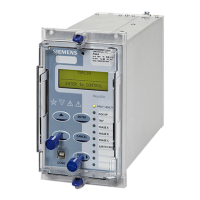7SR11 & 7SR12 Installation Guide
©2017 Siemens Protection Devices Limited Chapter 5 Page 5 of 32
Section 1: Installation
1.1 Packaging
Relays are supplied in packaging designed to mechanically protect them while in both transit and storage.
This packaging should be recycled where systems exist, or disposed of in a manner which does not provide a
threat to health or the environment. All laws and regulations specific to the country of disposal should be adhered
to.
1.2 Unpacking, Storage and Handling
On receipt remove the relay from the container in which it was received and inspect it for obvious damage. It is
recommended that the relay not be removed from its case.
If damage has been sustained a claim should be immediately be made against the carrier, also inform Siemens
Protection Devices Limited, and the nearest Siemens agent.
When not required for immediate use, Relays should be stored in their original packaging. The place of storage
should be dry and free from dust. It should also not exceed the storage temperature and humidity limits of the
Relay; given in the Performance Specification of this manual.
The relay contains static sensitive devices, which are susceptible to damage due to static discharge. The relay’s
electronic circuits are protected from damage by static discharge when the relay is housed in its case.
The relay element should not be withdrawn or reinserted into the relay case while auxiliary voltage is present.
There can be no requirement to disassemble any relay, since there are no user serviceable parts in the relay. If
any modules have been tampered with, then the guarantee will be invalidated. Siemens Protection Devices
Limited reserves the right to charge for any subsequent repairs.
1.3 Recommended Mounting Position
The relay uses a liquid crystal display (LCD) for programming and operation. The LCD has a vertical viewing
angle of ± 30˚ and is back–lit. However, the best viewing position is at eye level, and this is particularly important
given its control features.
The relay should be mounted on the circuit breaker (or protection panel) to allow the operator the best access to
the relay functions
1.4 Wiring
The product should be wired according to the scheme requirements, with reference to the appropriate wiring
diagram.
Wire specification and size should be selected to suit the application.
The device does not contain any internal fuse or other user serviceable protection components. Typically the PSU
is connected to the auxiliary supply via an external HRC fuse rated at 6A (BS88/IEC60269 or suitably rated
miniature circuit breaker may be installed. Isolation links may also be installed in accordance with user
requirements.
The equipment shall be isolated or disconnected from hazardous live voltage before access to potentially
hazardous live parts is affected.
Note that when the Relay is powered-up for the first time, it is good practice to do so with the trip and control links
removed. This limits potential damage caused by incorrect scheme wiring.

